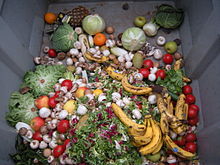
Biodegradable waste
| Part of a series on |
| Pollution |
|---|
 Air pollution from a factory
|
|
Digital
|
|
|
Biodegradable waste includes any organic matter in waste which can be broken down into carbon dioxide, water, methane, compost, humus, and simple organic molecules by micro-organisms and other living things by composting, aerobic digestion, anaerobic digestion or similar processes. It mainly includes kitchen waste (spoiled food, trimmings, inedible parts), ash, soil, dung and other plant matter. In waste management, it also includes some inorganic materials which can be decomposed by bacteria. Such materials include gypsum and its products such as plasterboard and other simple sulfates which can be decomposed by sulfate reducing bacteria to yield hydrogen sulfide in anaerobic land-fill conditions.
In domestic waste collection, the scope of biodegradable waste may be narrowed to include only those degradable wastes capable of being handled in the local waste handling facilities.
Biodegradable waste when not handled properly can have an outsized impact on climate change, especially through methane emissions from anaerobic fermentation that produces landfill gas. Other approaches to reducing the impact include reducing the amount of waste produced, such as through reducing food waste.
Sources
Biodegradable waste can be found in municipal solid waste (sometimes called biodegradable municipal waste, or as green waste, food waste, paper waste and biodegradable plastics). Other biodegradable wastes include human waste, manure, sewage, sewage sludge and slaughterhouse waste. In the absence of oxygen, much of this waste will decay to methane by anaerobic digestion.
In the UK, 7.4 million tonnes of biodegradable waste was sent to landfill in 2018 having reduced from 7.8 million tonnes in 2017.
Collection and processing
In many parts of the developed world, biodegradable waste is separated from the rest of the waste stream, either by separate curb-side collection or by waste sorting after collection. At the point of collection such waste is often referred to as green waste. Removing such waste from the rest of the waste stream substantially reduces waste volumes for disposal and also allows biodegradable waste to be composted.
Biodegradable waste can be used for composting or a resource for heat, electricity and fuel by means of incineration or anaerobic digestion. Swiss Kompogas and the Danish AIKAN process are examples of anaerobic digestion of biodegradable waste. While incineration can recover the most energy, anaerobic digestion plants retain nutrients and make compost for soil amendment and still recover some of the contained energy in the form of biogas. Kompogas produced 27 million Kwh of electricity and biogas in 2009. The oldest of the company's lorries has achieved 1,000,000 kilometers driven with biogas from household waste in the last 15 years.
Climate change impacts
Landfill gas

Landfill gas is a mix of different gases created by the action of microorganisms within a landfill as they decompose organic waste, including for example, food waste and paper waste. Landfill gas is approximately forty to sixty percent methane, with the remainder being mostly carbon dioxide. Trace amounts of other volatile organic compounds (VOCs) comprise the remainder (<1%). These trace gases include a large array of species, mainly simple hydrocarbons.
Landfill gases have an influence on climate change. The major components are CO2 and methane, both of which are greenhouse gasses. Methane in the atmosphere is a far more potent greenhouse gas, with each molecule having twenty-five times the effect of a molecule of carbon dioxide. Methane itself however accounts for less composition of the atmosphere than does carbon dioxide. Landfills are the third-largest source of methane in the US.
Because of the significant negative effects of these gases, regulatory regimes have been set up to monitor landfill gas, reduce the amount of biodegradable content in municipal waste, and to create landfill gas utilization strategies, which include gas flaring or capture for electricity generation.Food waste

Food loss and waste is food that is not eaten. The causes of food waste or loss are numerous and occur throughout the food system, during production, processing, distribution, retail and food service sales, and consumption. Overall, about one-third of the world's food is thrown away. A 2021 metaanalysis that did not include food lost during production, by the United Nations Environment Programme found that food waste was a challenge in all countries at all levels of economic development. The analysis estimated that global food waste was 931 million tonnes of food waste (about 121 kg per capita) across three sectors: 61 per cent from households, 26 per cent from food service and 13 per cent from retail.
Food loss and waste is a major part of the impact of agriculture on climate change (it amounts to 3.3 billion tons of CO2e emissions annually) and other environmental issues, such as land use, water use and loss of biodiversity. Prevention of food waste is the highest priority, and when prevention is not possible, the food waste hierarchy ranks the food waste treatment options from preferred to least preferred based on their negative environmental impacts. Reuse pathways of surplus food intended for human consumption, such as food donation, is the next best strategy after prevention, followed by animal feed, recycling of nutrients and energy followed by the least preferred option, landfill, which is a major source of the greenhouse gas methane. Other considerations include unreclaimed phosphorus in food waste leading to further phosphate mining. Moreover, reducing food waste in all parts of the food system is an important part of reducing the environmental impact of agriculture, by reducing the total amount of water, land, and other resources used.
The UN's Sustainable Development Goal Target 12.3 seeks to "halve global per capita food waste at the retail and consumer levels and reduce food losses along production and supply chains, including post-harvest losses" by 2030.Climate change mitigation strategies prominently feature reducing food waste. In the 2022 United Nations Biodiversity Conference nations agree to reduce food waste by 50% by the year 2030.
